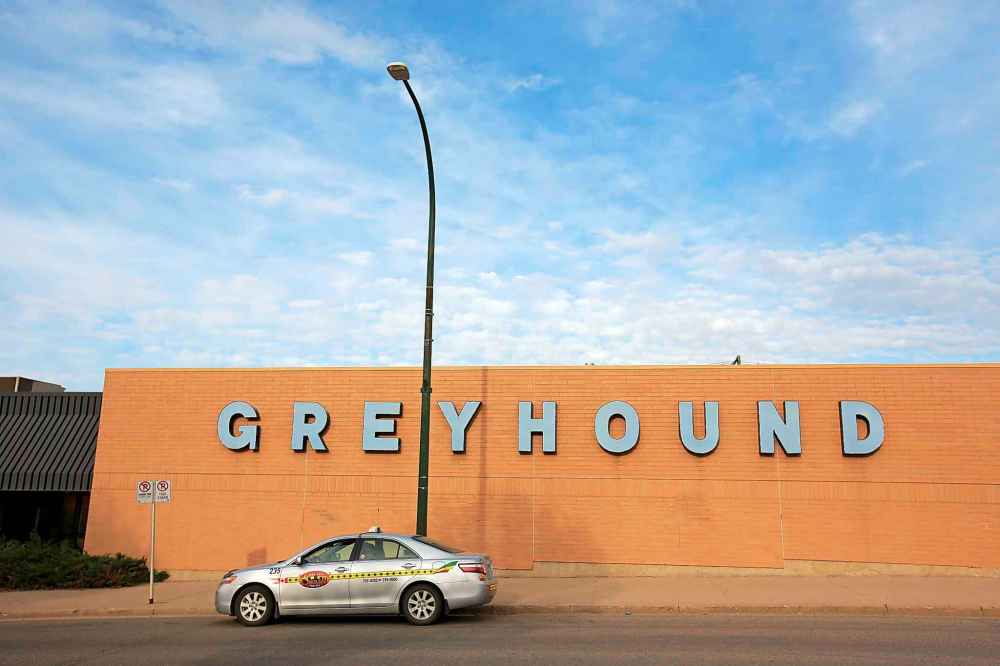Fallout from Greyhound departure More difficult for abused women to flee; union, workers surprised by decision
Read this article for free:
or
Already have an account? Log in here »
To continue reading, please subscribe:
Monthly Digital Subscription
$0 for the first 4 weeks*
- Enjoy unlimited reading on winnipegfreepress.com
- Read the E-Edition, our digital replica newspaper
- Access News Break, our award-winning app
- Play interactive puzzles
*No charge for 4 weeks then price increases to the regular rate of $19.00 plus GST every four weeks. Offer available to new and qualified returning subscribers only. Cancel any time.
Monthly Digital Subscription
$4.75/week*
- Enjoy unlimited reading on winnipegfreepress.com
- Read the E-Edition, our digital replica newspaper
- Access News Break, our award-winning app
- Play interactive puzzles
*Billed as $19 plus GST every four weeks. Cancel any time.
To continue reading, please subscribe:
Add Free Press access to your Brandon Sun subscription for only an additional
$1 for the first 4 weeks*
*Your next subscription payment will increase by $1.00 and you will be charged $16.99 plus GST for four weeks. After four weeks, your payment will increase to $23.99 plus GST every four weeks.
Read unlimited articles for free today:
or
Already have an account? Log in here »
Hey there, time traveller!
This article was published 10/07/2018 (2715 days ago), so information in it may no longer be current.
Greyhound’s exit will put abused women at greater risk, advocates warn
Greyhound Canada’s decision to abandon service on the Prairies will make it even more difficult for northern Manitoba women and their children to escape domestic abuse and access shelters, advocates warn.
“We’re putting women and children in danger with the absence of safe and reliable transit,” said Dawna Pritchard, executive director at Aurora House in The Pas, one of the only women’s shelters in the northern part of the province.

Greyhound announced Monday that it is ending service in the fall between British Columbia and northwestern Ontario.
Not only do women and children fleeing violence often rely on Greyhound routes to escape to Aurora House and shelters in southern Manitoba, but Pritchard said many also travel on the bus line’s routes to seek safety in other communities, get to hospitals and counselling appointments and, later, attend court hearings.
Bus firm plans to fill some Greyhound routes
A Thunder Bay-based transportation company has announced it’s expanding in Manitoba this fall, where it will run passenger bus routes left unused after Greyhound Canada’s decision to axe service in western Canada.
A Thunder Bay-based transportation company has announced it’s expanding in Manitoba this fall, where it will run passenger bus routes left unused after Greyhound Canada’s decision to axe service in western Canada.
Starting Oct. 31, the same day Greyhound plans to stop running, Kasper Transportation will run a route from Winnipeg to Thunder Bay, a Winnipeg-Regina-Saskatoon-Prince Albert route and a route from Winnipeg to Thompson.
The company plans to expand further in northern Manitoba.
“We had plans to expand into Manitoba for quite a long time, it’s always been part of our strategy,” said company owner Kasper Wabinski. “With Greyhound’s decision to pull out, it opens up the opportunity for us.”
The company currently operates routes between Sioux Lookout and Winnipeg, Sioux Lookout and Red Lake, and Winnipeg and Selkirk.
There are routes that need to continue in rural Manitoba, Wabinski said, emphasizing the importance of routes to Thompson and other northern communities.
At this point, Kasper mostly uses smaller buses in the 10-20 seat range, so the company is used to smaller markets with less demand, Wabinski said. With lower overhead and fewer real estate costs, he said he thinks Kasper can profit in rural Manitoba.
“If you look at each route individually, I think they’re more than profitable,” said Wabinski.”It’s just (Greyhound) can’t run those routes the Greyhound way. A bus depot is a lot of money.”
Transportation options for women in such circumstances are already scarce, she said, adding shelters simply don’t have room in their budgets to cover expensive taxi slips.
The result will be women in desperate situations making high-risk decisions, such as hitching rides.
“So we’re looking at that same kind of worrisome issue that arises with the Highway of Tears in B.C., where there is inadequate transportation,” she said. “So you’re putting women and children at risk.”
In a statement released Tuesday, the Native Women’s Association of Canada said the organization is “deeply concerned” for Indigenous women in rural communities and northern regions because of Greyhound’s decision.
Fewer transportation options will worsen the epidemic of missing and murdered Indigenous women and girls, NWAC wrote.
“The lack of safe transportation in and out of communities creates more vulnerability for Indigenous women, girls and gender-diverse people by encouraging travellers to resort to less safe means of transportation such as hitchhiking or walking unsafe highways,” the statement said.
Federal Crown-Indigenous Relations Minister Carolyn Bennett could not be reached for comment and her office did not provide a response to the statement.
Some women won’t be able to leave at all, said Kaitlin Bardswich, communications and development co-ordinator at Women’s Shelters Canada.
Bardswich noted the rates of domestic violence are higher in the North and territories in Canada while services are usually located in urban areas. According to the WSC, the average area served by rural shelters is equivalent — in square kilometres — to Belgium in size.
Ottawa expects provinces to take the wheel
OTTAWA — The federal government is reaching out to Prairie provinces to understand the impact of Greyhound Canada’s decision to end all service across the region this fall, but it is not considering subsidizing bus services.
OTTAWA — The federal government is reaching out to Prairie provinces to understand the impact of Greyhound Canada’s decision to end all service across the region this fall, but it is not considering subsidizing bus services.
Instead, sources say the Prime Minister’s Office has contacted provincial officials to see how Greyhound’s decision will impact public services paid by each level of government, and federal departments are suggesting provinces study whether private operators can fill the gaps.
Greyhound announced Monday it would cease all domestic service between British Columbia and northwestern Ontario.
Ottawa funds medical services on almost all First Nations, paying for flights and Greyhound tickets when residents have to leave their communities for treatment.
“Indigenous Services Canada (ISC) is analyzing the situation and will work closely with other federal departments, provincial governments, First Nations and other stakeholders to find solutions to challenges this situation may pose for medical transportation,” wrote department spokeswoman Martine Stevens.
The federal policy requires “the most appropriate, efficient, and economical mode of transportation,” which ranges from paying for mileage and bus tickets to chartering group flights and even taxis and snowmobile rides. It also subsidizes First Nations-run shuttles to Winnipeg.
Transport Minister Marc Garneau’s office said it was monitoring the situation and contacting Greyhound “to better understand the impacts on Canadians,” but that intercity bus lines fall under provincial jurisdiction.
“The federal government encourages all intercity bus operators to work with the provinces to foster conditions that will support a viable bus industry,” wrote spokeswoman Delphine Denis.
Greyhound notified Manitoba’s Motor Transport Board of the service changes “just prior to public notification,” a provincial spokesman wrote Tuesday.
Provincial rules say a carrier must give 90 days of public notice before discontinuing a route, meaning Monday’s announcement falls within the law. “Otherwise, Greyhound is a private company and cannot be compelled to continue to offer service in Manitoba,” the spokesman said.
In September 2009, Greyhound threatened to end all of its Manitoba service within a month, claiming that the MTB too strictly regulated fares and service schedules.
At the time, the company asked for a $15-million subsidy to break even on what it said were a dozen money-losing routes to 160 communities. Ultimately, the province offered $3.1 million to keep the company maintaining the same service.
In 2012, the province changed its MTB regulations, allowing Greyhound to change routes, fares and schedules if they gave 30 days public notice. That year, Greyhound axed 12 of its Manitoba routes and scaled back others. In 2015, it cut its Brandon-Winnipeg service in half, offering just one daily departure in each direction.
The MTB will be shuttered this year under Bill 14, with the Pallister government trying to incentivize more private transportation services.
Back in 2009, union officials noted that Greyhound had lost passenger traffic to northern First Nations that were operating their own bus services to Winnipeg. Now, it’s unknown whether a Greyhound pullout this fall would lead to Ottawa having to pay for hours-long taxi rides to Winnipeg, or if it would instead choose to fund more First Nations-operated shuttles.
Northern Manitoba MP Niki Ashton said Monday she wants the province and Ottawa to craft some form of public transportation for her riding. That would reverse a trend of governments walking away from bus services, as was the case last May when the Saskatchewan government shuttered its coach service after 70 years of operation. Ottawa provides no subsidies to bus carriers.
In 2002, when Greyhound’s parent company Laidlaw was heading toward bankruptcy, the Senate transportation committee studied the industry and found passenger traffic had declined by a third from 15 years prior.
The committee suggested that issuing federal tax credits and clarifying the patchwork of provincial regulations could help ensure ongoing bus service for Canadians with few other options.
But Transport Canada said a 2010 joint task force between the provinces and the federal opted against national subsidies, saying that “individual jurisdictions could subsidize specific routes and carriers on a case-by-case basis.”
Department spokesman Pierre Manoni wrote that there have been a series of cutbacks over the past decade. “In many cases, these service gaps are filled by other bus companies, and by other modes.”
— Dylan Robertson
“Transportation is already a huge issue with rural shelters. With this, it’s going to become an even bigger issue,” she said.

“One of the factors that causes women to stay in abusive situations is the idea that they can’t leave, whether that’s financial or physical,” she said, adding that fewer ways to leave town means women and children’s lives are “in jeopardy.”
Laura Matychuk, who chairs the board that oversees Genesis House women’s shelter in Winkler, said the route cuts make dangerous situations even worse.
“We’re just taking options away from people, and it’s people who need to get out of dangerous circumstances,” she said.
Bardswich said WSC hopes governments will provide more funding — specifically for transportation — to women’s shelters now that Greyhound is abandoning Western Canada.
Greyhound’s decision surprised union and workers
Greyhound didn’t demand concessions from its employees in the days and weeks leading to its decision to shut freight and passenger service in Western Canada — nor did it offer hints of its intentions, the union representing 440 affected workers says.
Eric Carr, president and business agent of Amalgamated Transit Union Local 1374, said he learned of the transportation giant’s intentions late Sunday evening. Affected employees include about 75 bus drivers, mechanics, pickup and delivery drivers and freight handlers in Winnipeg and Thompson.
Carr said in an interview from Calgary Tuesday there was a feeling among workers that Greyhound may one day scale back service, concentrating on lucrative regional routes that include Winnipeg to Thompson, Calgary to Edmonton and Vancouver to Kelowna.
Canadian employees suspected that routes with “big dead areas” such as Winnipeg to Thunder Bay and Thunder Bay to White River, Ont., could be on the chopping block, he said.
“We felt that those kinds of spots would be gone, but nobody was feeling that the entire region (from Sudbury to the West Coast) would be shut down,” Carr said.
He said when he asked company officials late Sunday why they didn’t meet with the union to discuss its collective agreement or hours of work, he was told that Greyhound felt that the economic challenges of operating in Western Canada were insurmountable.
“They never came to the union to have any discussions prior to making this announcement on Monday,” he said.
Carr said he was told the only way the company could see itself operating in Western Canada in the future is if it was subsidized to the same extent as Via Rail.

Greyhound didn’t hint that it was holding out for such subsidies when it announced Monday that it was discontinuing service in the West as of Oct. 31. Stuart Kendrick, Greyhound Canada’s senior vice-president, could not be reached for comment on Tuesday.
The Manitoba government made it clear on Monday that it would not consider any corporate handouts. Instead, Infrastructure Minister Ron Schuler said he hoped new or existing carriers, including ones operated by First Nations, would fill the service gap.
Carr said he has received assurances that Greyhound will continue to fund Canadian employees’ defined benefits pension plan. He said that will be a relief to the soon-to-be-laid-off workers, many of whom have 20-30 years service with the company.
He said Texas-based Greyhound has always treated its Canadian operations like “a poor cousin.” At one time, he noted, there were 1,500 Greyhound workers in Western Canada.
Carr said the union believes there is a viable intercity bus business in Western Canada and that there are opportunities for new service providers to emerge.
Greyhound first threatened to withdraw its services from Manitoba in 2009. The province agreed to millions of dollars in subsidies over the next few years to maintain the service. In 2012, Manitoba eased its regulatory grip on the company, allowing it to drop unprofitable lines. Greyhound was also able to withdraw service on any route in Manitoba after giving 90 days notice.
Meanwhile, Greyhound’s departure this fall raises the question of what will become of its 30,000-square-foot facility at the Richardson International Airport, constructed at a cost of $7 million a decade ago. Greyhound had signed a 40-year lease on the building.
Michael Badejo, a spokesman for the Winnipeg Airports Authority, said the WAA expects to discuss the matter soon with Greyhound.
“They’re still abiding by their agreement and we’ll have additional discussions with them in the coming days before their action comes into effect in the fall,” Badejo said in an email. He said the airports authority is unable to share details of the lease agreement with Greyhound “at the moment.”
A spokeswoman for Greyhound said in an email that the company has requested a meeting with the WAA to discuss options regarding the lease. “Greyhound intends to fulfil all its responsibilities while it pursues available options,” which could include arranging for a sublease, the spokeswoman said.
larry.kusch@freepress.mb.ca

Maggie Macintosh reports on education for the Winnipeg Free Press. Funding for the Free Press education reporter comes from the Government of Canada through the Local Journalism Initiative.

Our newsroom depends on a growing audience of readers to power our journalism. If you are not a paid reader, please consider becoming a subscriber.
Our newsroom depends on its audience of readers to power our journalism. Thank you for your support.










